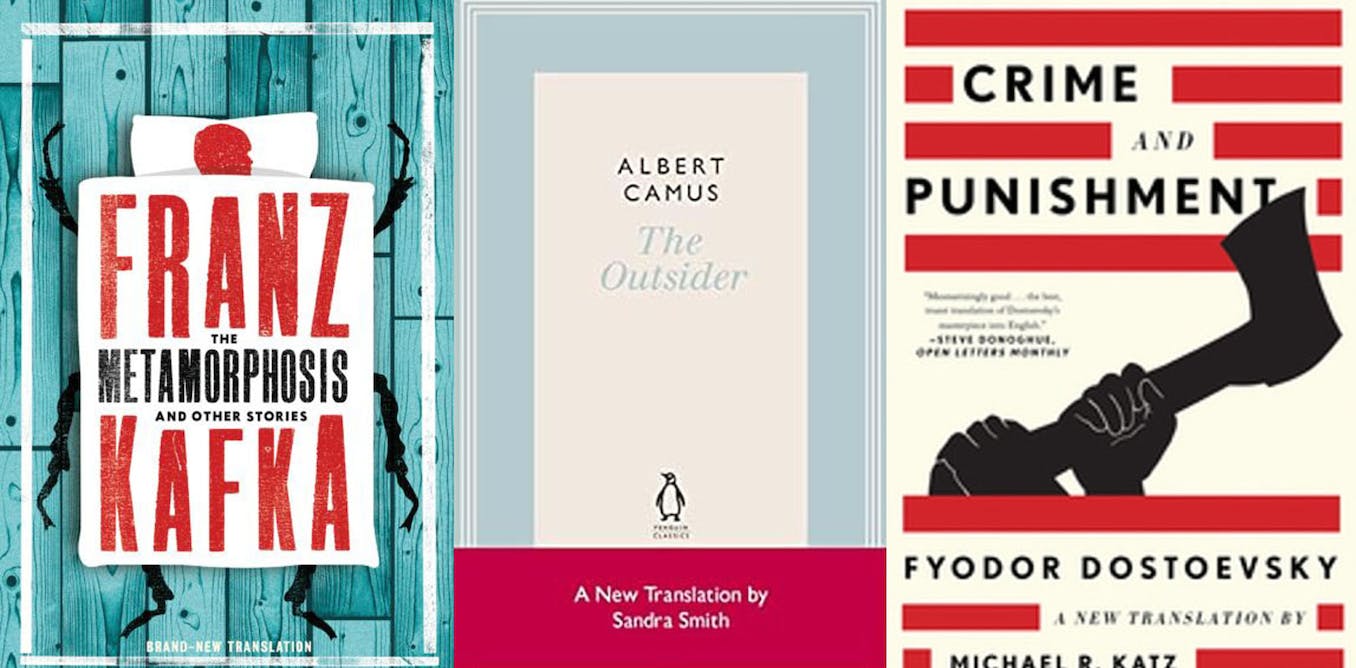While browsing the shelves of a library or a bookshop in search of the adventures of Gregor Samsa or Raskolnikov, you may be facing an impossible dilemma. Which version of the Metamorphosis or Crime and Punishment should you choose? Because in a particularly well-stocked library or bookshop, you could find more than ten different English translations of these two literary classics.
We’re not talking of different editions here, but of different texts, different words. In fact, people say and think having read Kafka or Dostoevsky, but what they have actually read are the words of Willa and Edwin Muir, Susan Bernofsky, Christopher Moncrieff, or again those of Constance Garnett, David McDuff or Michael Katz, to name just a few of the English translators of these two masterpieces of world literature.
The art of choosing a translation
So, which translation should you choose? Most readers will make their choice according to the same criteria that drive their choice of an English classic: affection for a publishing house or a particular collection, introduction and other paratexts, price, book cover, etc. Very few of them will be influenced in their choice by the renown of their translators, those invisible figures of translated literature, and silent actors of an interpretation which is often perceived as impersonal and objective, and certainly not crucial.
By the way, why all this fuzz around one single book? A legitimate question, given the countless books which are still awaiting their first translation – especially so in English, a language from which the whole world widely translates, but which itself translates very little from other languages (see the Three Percent project for a reaction to the small percentage of translated literature in the United States). If the primary goal of a translation is to make a book accessible to an audience who is unable to read it in its source language, then retranslations are clearly operations of little to no use. And yet, very few English speakers today read Dante, Cervantes or Rabelais in a century-old English translation, not to say older. On the contrary, Italian, Spanish and French speakers (and English speakers, for that matter) do continue to read their own leading authors in a language that is several centuries old, duly assisted in the process by long, explanatory notes.
So why do we keep retranslating our foreign literary classics? Because a classic is a text that we never stop retranslating, one might say, reversing the terms of the question. The phenomenon of retranslation is both paradoxical and inherent in every culture, to the point that an historian of translation, Michel Ballard, has identified it as one of the few constant features in the history of translation.
Censorship, inaccuracies and ageing
There are, of course, many reasons behind such urge to retranslate. Most often, the driving force behind a retranslation – or new translations, as the publishers quite obviously prefer naming them – is a sense of dissatisfaction with previous translations. Because of some forms of ideological or moral censorship, for instance, which may have deprived its readers of certain aspects of the book. No need of a dictatorship to see a text stripped of certain references to the culture which produced it: the simple decision to make the book accessible to new readers involves applying some cultural filters to it (regarding food, habits, sports, or other culture-specific items). In other cases, the sense of dissatisfaction may be due to errors or inaccuracies, originated by human fallibility or limited resources. Just think for a moment to the working conditions of pre-Internet translators, for whom some basic fact-checking could require several days of research, and that only thirty years ago.
Take one of the most famous so-called “errors” in the history of translation, the horns on the head of Michelangelo’s Moses (1515). The artist based his work on the Latin translation of the Bible carried out by St. Jerome some 1,100 years earlier (supreme longevity for a translation). Hebrew, a consonantal language, dispenses with vowel indications, thus opening the way to an ambiguity between keren (horned) and karan (radiant), in a crucial passage of the Exodus. While Jerome interpreted it as “horned,” inspiring much of the Christian iconography of the centuries to come, all contemporary translations of the Bible give Moses a radiant, beaming face upon receiving the tablets of the law. The possible ambiguity of that wording was cleverly recreated by Chagall’s “intersemiotic” translation, which found in a different medium a way to attribute Moses true horns of light.
Fourni par l’auteur
One of the most frequently cited reasons for retranslating is that translations inevitably age. What about “originals”? They age too, of course, but not quite in the same way. They seem to ripen with age, whereas translations often turn grotesque. The difference lies essentially in the status of originals and translations: as a derivative text, a translation cannot exist without the primary text from which it comes from, and this secondary status deprives it of the authority of a “true” literary text. One may add to that the fact, widely demonstrated by corpus linguistics, that translations tend to be stylistically more conservative than their sources, and therefore may lack that unique charge of meaning which is the essence of a literary masterpiece.
The impression of ageing can also come from a better knowledge of the target culture, particularly with regard to certain cultural elements which have become commonplace: a footnote explaining what sushi is would not only be unnecessary today, but decidedly comical.
Sometimes retranslations bring forth major changes, in either titles, character names or key concepts, often triggering inflamed reactions from both critics and readers. Whether Camus’s hero was a stranger or an outsider (and whether it was his mother, mommy or maman who died at the beginning of the novel) is debatable and indeed got readers and critics talking. Divine temptations, however, proved much more controversial and destabilising, as shown by the reactions stirred by the reform of the Lord’s prayer. Retranslations can be disturbing because they introduce relativism into an interpretation which we thought of as definitive and unique. Translation scholars Susan Bassnett and André Lefevere came to define it as the “Proust’s Grandmother effect,” drawing on her disappointment in reading a new translation of the Odyssey where Ulysses had become Odysseus. Other scholars, such as Lawrence Venuti, also observed a somewhat nostalgic reaction on the part of some readers, when confronted with new translations of classical works.
In some cases, it is the very text that we thought of as “original” which turns out to be derivative: for instance, the most recent retranslations of Kafka resort to a “new” version of the German text, liberated from Max Brod’s editing.
In a few cases, retranslations are simply determined by commercial or editorial reasons, since it may be easier, cheaper and more lucrative (or the three things at once) to propose a new translation rather than to reissue an old one.
Can we anticipate the path of a translation series?
In the wake of Antoine Berman (1990), a pioneering translator scholar in this field, a “retranslation hypothesis” has been put forward, to describe the direction of translation-retranslations series. According to such hypothesis, first translations would tend to be introductory works which “domesticate” foreign texts in order to make them acceptable to their target audience, and retranslations would be more and more inclined to come closer to the source text and display its multiple facets. Such a vision of a progressive approach toward a perfect identity with “originals” is certainly fascinating, but unrealistic, as it fails to take into account the multiple reasons behind a retranslation. As a counterexample, one may think of the free translations/adaptations of Greek and Latin classics in the 1600-1700, during the era of so-called “belles infidèles” or “libertine translations”: they were mostly retranslations, yet as distant as possible from their sources.
Can we anticipate when and how often a classic will be retranslated? Several hypotheses have been put forward: every century, every generation, every 20 years… However, the series of translations and retranslations of a literary classic show very little regularity, and quite unpredictable gaps, jumps or accelerations. Several case studies exist, but still no exhaustive studies providing reliable, large-scale statistics for a given period, genre or country. The only prediction we can make is the appearance of a peak in retranslations when canonised authors fall into the public domain, i.e., 70 years after their death in Europe. At this time, publishers are inevitably prompted to issue new translations of such authors, in order to capitalise on their cultural power. In the first weeks of 2015, for example, Turkish readers found no fewer than 30 versions of The Little Prince, as soon as the novella fell in the public domain in Europe (but beware, not in France, nor in the United States yet).
In 1994, Isabelle Collombat, professor at the Université Sorbonne-Nouvelle, predicted that the 21st century would be the age of retranslation. Upcoming studies will tell us whether this is indeed the case. One thing is certain: retranslation has a bright future ahead. It is the perfect antidote to the idea of a unique translation, and it reminds us that every single translation relies on a peculiar process of interpreting and rewriting. And that multiple readings, such as metamorphoses, are not a crime, but a true source of vitality for literature, and of pleasure for the reader.


